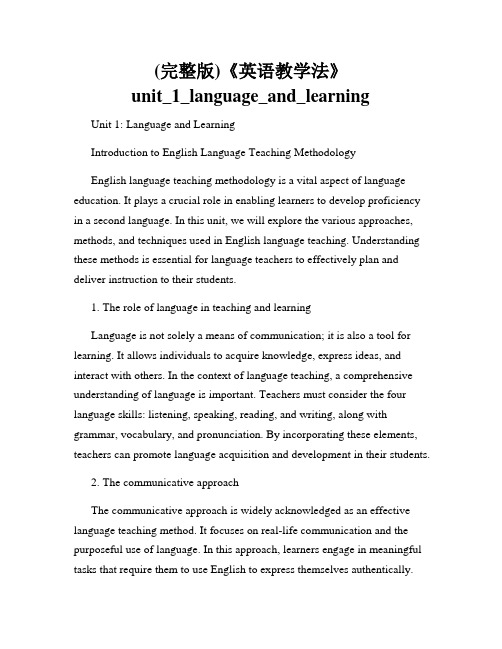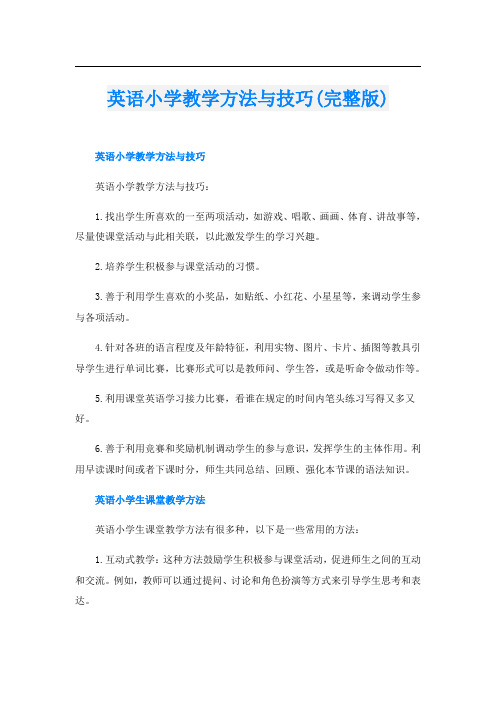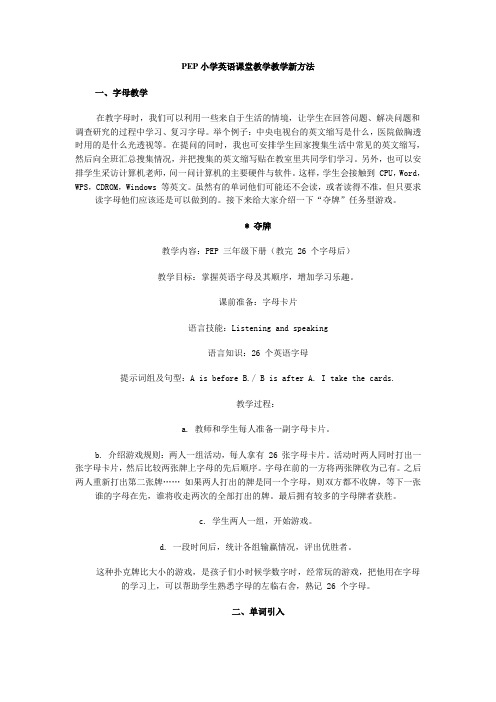(完整版)小学英语教学法教程
(完整版)《英语教学法》unit_1_language_and_learning

(完整版)《英语教学法》unit_1_language_and_learning Unit 1: Language and LearningIntroduction to English Language Teaching MethodologyEnglish language teaching methodology is a vital aspect of language education. It plays a crucial role in enabling learners to develop proficiency in a second language. In this unit, we will explore the various approaches, methods, and techniques used in English language teaching. Understanding these methods is essential for language teachers to effectively plan and deliver instruction to their students.1. The role of language in teaching and learningLanguage is not solely a means of communication; it is also a tool for learning. It allows individuals to acquire knowledge, express ideas, and interact with others. In the context of language teaching, a comprehensive understanding of language is important. Teachers must consider the four language skills: listening, speaking, reading, and writing, along with grammar, vocabulary, and pronunciation. By incorporating these elements, teachers can promote language acquisition and development in their students.2. The communicative approachThe communicative approach is widely acknowledged as an effective language teaching method. It focuses on real-life communication and the purposeful use of language. In this approach, learners engage in meaningful tasks that require them to use English to express themselves authentically.The communicative approach encourages learners to develop their fluency and accuracy by providing opportunities for interaction and authentic communication.3. The lexical approachThe lexical approach emphasizes the importance of teaching vocabulary and collocations in language learning. It recognizes that grammar and vocabulary are interconnected and that learners must acquire both to communicate effectively. Teachers following the lexical approach prioritize teaching high-frequency and useful vocabulary, as well as the collocations and phrases associated with them. By developing a strong lexical repertoire, learners can enhance their language proficiency and understanding.4. Task-based language teachingTask-based language teaching (TBLT) is a learner-centered approach that focuses on the completion of meaningful tasks. In TBLT, learners are presented with a task that requires the use of language to accomplish a specific goal. These tasks can be simulations of real-life situations or problem-solving activities. By engaging in these tasks, learners develop their language skills while also achieving the task objective. TBLT promotes both language acquisition and the development of critical thinking and problem-solving skills.5. Technology-enhanced language teachingTechnology has revolutionized language teaching and learning. It provides teachers and learners with access to an array of digital resources and tools. Technology-enhanced language teaching encompasses the use ofeducational software, online platforms, multimedia materials, and interactive activities. It enhances learner engagement and provides opportunities for independent learning. Integration of technology in language teaching opens up new possibilities for personalized and adaptive instruction.ConclusionEnglish language teaching methods continually evolve to meet the needs of diverse learners. It is essential for language teachers to keep abreast of current approaches and techniques to maximize instructional effectiveness. The approaches discussed in this unit, including the communicative approach, lexical approach, task-based language teaching, and technology-enhanced language teaching, provide teachers with valuable frameworks to deliver comprehensive and engaging language instruction. By applying these methods, language teachers can foster language learning and promote language proficiency development in their students.(Word count: 585)。
小学英语五步教学法教案精品PPT课件 图文

How to train Ss take part in the organization, we should pay attention to the following principles :
教师在组织学生进行操练的时候, 要注意把握以下操练的原则:
1) 针对性原则:
Specific principle: practice should base on the teaching contents and teaching specific targets;
4) 激励性原则:
Incentive principle : praise the Ss all the time and give them confidence; for backward students just ask easier questions, once they get correct answers, we must praise immediately. Encouraging and inspiring students should be remembered all the time.
3) 激发性原则:
Simulative principle: the question should face all Ss; first asking question, then looking for somebody to answer; 提问题的时候要面向全体,先提问,后找人 回答;
Tell the directions east,west,south, north correctly.
Point to the positions of cities correctly.
小学英语的教学方法有哪些精选5篇

小学英语的教学方法有哪些精选5篇小学英语教学法篇一1、直观教学法在教学时,有些教学材料贴近于生活,能充分反映小学生的日常生活,所以教师应该有效地利用资源,如运用实物或图片、教具等进行演示,使学生头脑中形成比较鲜明的事物表象,丰富学生的感性认识,这样不仅能激发学生的学习兴趣,还能使他们将所学的内容应用到他们的生活中去。
如在学习book , pencil 等学习用品和apple ,orange 等水果时,就可以利用水果实物或图片进行教学,使抽象的单词直观化,使英语的学习过程更具趣味性。
2、情境教学法3、模仿练习法英语学习需要学生的模仿练习,因为英语的语音、语调及书写必须准确无误。
为此,教师在范读字母、单词或句子之前,应该让学生听老师的读音,看老师的口形,进行认真的模仿练习。
引领学生反复训练,鼓励学生大胆张口。
4、儿歌说唱法对于中低年级的学生,我们可以根据其特点,将学习的内容编成一些顺口易记的歌诀,如:丁丁、丁丁真能干,学习思考用head,小小eye 看黑板,竖起ear认真听,mouth、mouth长得巧,讲起英语都说好,nose、nose嗅觉灵,foot、foot踢足球,arm、arm来举重,长长leg跳绳快,虽然比赛伤了toe,领奖face乐开了花,全班拍着hand,夸他为班争了光。
学生在背歌诀时,脑、口、耳并用,还可以配以肢体表演,这样的英语学习是愉快的,调动了学生的学习积极性,让学生在轻松愉悦的气氛中学习,使他们感到学习不再是一种负担,而是一种乐趣。
教学有法,教无定法,贵在得法。
我觉得小学生学英语就像学游泳一样,必须让学生泡在水中、潜到水里去,这样他最后才能成为一个熟练的游泳者,自在游泳乐在其中。
因此,英语教师应激发学生的学习兴趣,给学生尽量多地创造听、说、练的机会,让学生在动中学,学中乐,使之获得语言知识技能,真正达到轻松学英语、轻松用英语的目的。
5、表演法如在“In the morning”这一单元后,我们的表演要求就是:把一天从早晨醒来到上学这一阶段的生活用英语表演出来。
英语小学教学方法与技巧(完整版)

英语小学教学方法与技巧(完整版)英语小学教学方法与技巧英语小学教学方法与技巧:1.找出学生所喜欢的一至两项活动,如游戏、唱歌、画画、体育、讲故事等,尽量使课堂活动与此相关联,以此激发学生的学习兴趣。
2.培养学生积极参与课堂活动的习惯。
3.善于利用学生喜欢的小奖品,如贴纸、小红花、小星星等,来调动学生参与各项活动。
4.针对各班的语言程度及年龄特征,利用实物、图片、卡片、插图等教具引导学生进行单词比赛,比赛形式可以是教师问、学生答,或是听命令做动作等。
5.利用课堂英语学习接力比赛,看谁在规定的时间内笔头练习写得又多又好。
6.善于利用竞赛和奖励机制调动学生的参与意识,发挥学生的主体作用。
利用早读课时间或者下课时分,师生共同总结、回顾、强化本节课的语法知识。
英语小学生课堂教学方法英语小学生课堂教学方法有很多种,以下是一些常用的方法:1.互动式教学:这种方法鼓励学生积极参与课堂活动,促进师生之间的互动和交流。
例如,教师可以通过提问、讨论和角色扮演等方式来引导学生思考和表达。
2.多媒体教学:多媒体教学可以利用图像、声音、视频等多种形式来呈现教学内容,增强学生的感官体验和学习兴趣。
教师可以利用多媒体课件、教学视频等资源来辅助教学。
3.游戏化教学:这种方法将游戏元素引入教学中,让学生在游戏中学习和掌握知识。
例如,教师可以设计一些拼图、填空、谜语等小游戏来帮助学生记忆单词、语法和句型等。
4.合作学习:这种方法鼓励学生之间合作学习和交流,培养学生的团队合作精神和沟通能力。
教师可以组织小组讨论、角色扮演、游戏竞赛等活动来促进合作学习。
5.创造语言环境:这种方法通过创造真实的语言环境,让学生在实际场景中学习和使用英语。
例如,教师可以组织学生参加英语角、英语俱乐部等活动,让学生在真实的语言环境中与外国人交流和互动。
以上是一些常用的英语小学生课堂教学方法,教师可根据学生的特点和需求选择适合的方法进行教学。
小学英语教学方法有哪几种以下是小学英语教学方法:1.情景法。
《小学英语教法》课程教案第一章 概论

《小学英语教法》课程教案授课教师教研室职称授课班级地点本次课题第一章概论授课时数课程类型理论实践授课内容授课顺序1.导课2.小学英语教学的意义及要求3.学习小学英语教学法的意义、内容及方法4.小结5.作业与指导教学目的1.初步理解小学英语教学的意义及要求。
2.学习小学英语教学法的意义、内容及方法。
教学重点深入理解小学英语教学的任务给英语教师带来的变化。
教学难点培养学生对小学英语教学法这门学科的兴趣。
教学设计课程导入教学方法讨论法、讲解法、任务驱动法教学手段及应用的教具多媒体课件教学步骤与内容教学基本内容备注第一节小学英语教学的意义及要求一、热身问题:(一)全世界有哪些国家使用英语,英语有何使用价值?(二)为什么我国目前要求在小学开设英语课程?(三)小学生学习英语具有哪些特点和优越条件?(学生通过小组讨论,可以结合教材发表自己的观点。
)二、小学英语教学应为初级中学的英语教学奠定基础:这个基础主要指的是培养学生具有初步运用所学语言知识进行听、说、读、写的能力。
三、小学英语教学的任务:通过看、听、说、玩、唱等一系列教学活动,对学生进行听、说、读、写的基本训练,激发学生学习英语的兴趣和动机,培养学生良好的学习习惯,使学生获得一些英语的感性知识,打下较好的语音基础,学习一定量的词汇,接触一定量的日常交际用语,从而具有以听说能力为主的初步交际能力,同时在英语学习中受到良好的思想品德教育,个性得到健康和谐的发展。
四、小学英语教学对英语教师有哪些要求?教师要结合学生的年龄、心理特点创造性地使用课本。
这就要求教师应从教授语言、发展智力、培养非智力因素三方面努力,搞好英语的教与学活动,运用恰当的教学方法,通过小学英语课堂教学活动的趣味性、直观性、实践性使小学生爱学,会学,主动学。
第二节学习小学英语教学法的意义、内容及方法一、学习小学英语教学法的意义:(一)语言教学既是一门科学,又是一门艺术,对不同阶段、不同目的的学习者应该使用不同的教学方法。
pep小学英语课堂教学教学新方法

PEP小学英语课堂教学教学新方法一、字母教学在教字母时,我们可以利用一些来自于生活的情境,让学生在回答问题、解决问题和调查研究的过程中学习、复习字母。
举个例子:中央电视台的英文缩写是什么,医院做胸透时用的是什么光透视等。
在提问的同时,我也可安排学生回家搜集生活中常见的英文缩写,然后向全班汇总搜集情况,并把搜集的英文缩写贴在教室里共同学们学习。
另外,也可以安排学生采访计算机老师,问一问计算机的主要硬件与软件。
这样,学生会接触到 CPU,Word,WPS,CDROM,Windows 等英文。
虽然有的单词他们可能还不会读,或者读得不准,但只要求读字母他们应该还是可以做到的。
接下来给大家介绍一下“夺牌”任务型游戏。
* 夺牌教学内容:PEP 三年级下册(教完 26 个字母后)教学目标:掌握英语字母及其顺序,增加学习乐趣。
课前准备:字母卡片语言技能:Listening and speaking语言知识:26 个英语字母提示词组及句型:A is before B./ B is after A. I take the cards.教学过程:a. 教师和学生每人准备一副字母卡片。
b. 介绍游戏规则:两人一组活动,每人拿有 26 张字母卡片。
活动时两人同时打出一张字母卡片,然后比较两张牌上字母的先后顺序。
字母在前的一方将两张牌收为己有。
之后两人重新打出第二张牌……如果两人打出的牌是同一个字母,则双方都不收牌,等下一张谁的字母在先,谁将收走两次的全部打出的牌。
最后拥有较多的字母牌者获胜。
c. 学生两人一组,开始游戏。
d. 一段时间后,统计各组输赢情况,评出优胜者。
这种扑克牌比大小的游戏,是孩子们小时候学数字时,经常玩的游戏,把他用在字母的学习上,可以帮助学生熟悉字母的左临右舍,熟记 26 个字母。
二、单词引入* 缤纷世界教学内容: PEP 四年级下册 Unit 5 A Let's learn教学目标:能听、说、读、写单词 colourful.课前准备:教师准备红、黄、蓝、粉红、棕、白、绿、黑色等不同颜色的花朵和一张白纸。
小学英语教学法教程

小学英语教学法教程
一、课堂环境创设:
提供一个积极、活跃、愉快的语言学习氛围,布置课堂环境时,可以在黑板上展示一些英文单词、图片等,吸引学生的注意力。
二、多媒体辅助教学:
利用图片、卡片、录音机、PPT等多媒体设备辅助教学,激发学生的学习兴趣,帮助他们更好地理解和记忆英语知识。
三、情境教学法:
运用情境教学法可以帮助学生更好地理解和运用英语知识。
可以通过角色扮演、图片讲解等方式,将英语知识融入到真实的情境中,让学生在实践中学习。
四、游戏教学法:
通过丰富多样的游戏活动来教授英语知识,如拼图游戏、说故事游戏等。
这些有趣的游戏可以增加学生的参与度,让他们在游戏中温故知新,提高他们的英语口语表达能力。
五、竞赛教学法:
组织各类英语竞赛,如英语拼字比赛、口语对话比赛等,激发学生学习英语的积极性,培养他们的团队合作意识和竞争意识。
六、故事教学法:
通过讲述英语故事来教授英语知识,帮助学生理解单词、句子的用法和意义,培养他们的阅读能力和想象力。
七、趣味教学法:
在教学中加入一些趣味元素,如唱歌、跳舞、手工制作等,让学生在轻松愉快的氛围中学习英语,提高他们的学习兴趣和参与度。
八、个别辅导教学法:
根据学生个体差异和学习需求,进行个别辅导,帮助学生解决困惑,巩固学习成果。
以上是一些小学英语教学法的介绍,教师可以根据学生的实际情况和自身教学经验选择适合的教学方法,让学生在轻松愉快的学习氛围中取得更好的学习效果。
2019小学英语教材教法(完整版)

赠送:小学英语教材教法【知识点】基础教育阶段英语课程的任务是什么?1.激发和培养学生学习英语的兴趣,使学生树立自信心,养成良好的学习习惯和形成有效的学习策略,发展自主学习的能力和合作精神。
2.使学生掌握一定的英语基础知识和听、说、读、写技能、形成一定的综合语言运用能力和创新精神。
3.培养学生的观察、记忆、思维、想象力和创新精神。
4.帮助学生了解世界和中西文化的差异,拓展视野,培养爱国主义精神,形成健康的人生观,为他们的终身学习和发展打下了良好的基础。
【知识点】英语课程标准的基本观念是什么?1.面向全体学生,注重素质教育。
2.整体设计目标,体现灵活开放。
3.突出学生主体,尊重个体差异。
4.采用灵活途径,倡导体验参与。
5.注重过程评价,促进学生发展。
6.开发课程资源,拓展学用渠道。
【知识点】英语课程设计思路采用国际通用的分级目标结构,保证国家英语标准的整体性、灵活性和开放性,有利于哪四个方面?1.有利于解决以往各学段之间缺乏衔接,教学内容和要求重复,一刀切等现象,保证英语教学的连续性。
2.有利于解决各地英语教育发展不平衡的矛盾。
3.有利于因材施教,分层教学和体现个性化学习的多教学模式的建立。
4.有利于《基础教育课程改革纲要(试行)》所提出“为保障和促进课程对不同地区、学校、学生的要求,实行国家、地方和学校三级课程管理”目标的实现。
【知识点】英语课程目标按照国际通用的能力水平设立几个级别?各级别都适用于哪个年级?设为九个级别。
从三年级开设英语课程的学校,三、四年级应完成一级目标,五、六年级完成二级目标,七-九年级分别完成三、四、五级目标,高中阶段完成六、七、八级目标,第九级为外国语学校和外语特色学校高中毕业课程目标的指导级,该级别也可以作为部分学校少数英语特长学生基础教育阶段的培养方向。
【知识点】基础教育阶段英语课程的总目标是什么?它建立在哪几个方面的基础上?每个方面都起什么作用?基础教育阶段英语课程的总体目标是:培养学生的综合语言运用能力。
- 1、下载文档前请自行甄别文档内容的完整性,平台不提供额外的编辑、内容补充、找答案等附加服务。
- 2、"仅部分预览"的文档,不可在线预览部分如存在完整性等问题,可反馈申请退款(可完整预览的文档不适用该条件!)。
- 3、如文档侵犯您的权益,请联系客服反馈,我们会尽快为您处理(人工客服工作时间:9:00-18:30)。
Module 3
Managing the teaching and learning process
1) Teachers’ and learners’ language in the classroom: using language appropriately for a range of classroom functions, identifying the functions of learners’ language, categorizing learners’ mistakes
2) Selection and use of resources and materials: consulting reference resources, selection and use of course-book, selection and use of supplementary materials and activities, selection and use of teaching aids
3) Background to language teaching:
presentation techniques and introductory activities, practice activities and tasks for language and skills development, assessment types and tasks
5. The natural order hypothesis
4.The Cognitive Approach
❖ Rules learning is very important; ❖ Learners should be encouraged to use their
mind to observe, think, and hypothesize rules of a language; ❖ Creative learning is very important; ❖ Listening, speaking, reading and writing should all be emphasized. ❖ The main activities are language understanding, language competence and language use.
1)Describing language and language skills: grammar, lexis, phonology, functions, reading, writing, listening, speaking
2) Background to language learning:
Module 2
Lesson planning and use of resources for language teaching
1) Planning and preparing a lesson or sequence of lessons: identifying and selecting aims, identifying the different components of a lesson plan, planning an individual lesson or a sequence of lessons, choosing assessment activities
discovered; ❖ Mother tongue is forbidden as it is
regarded as interference to foreign language.
3.The Natural Approach
Krashen’s five theories 1. Learning and acquisition theory
❖ Errors are regarded as natural and unavoidable and can be self corrected by the learners themselves;
❖ Grammar should be taught inductively;
❖ Native language is forbidden.
2) Classroom management: teacher roles, grouping learners, correcting learners, giving feedback
❖ To sum up, TKT consists of 3 parts: Language and background to language learning and teaching, Lesson planning and use of resources for language teaching, and Managing the teaching and learning process(语言知识和 语言技能及语言教与学背景、备课和教学设计、 课堂教学管理三方面)
3. The affective filter hypothesis
Affective factors such as interest, motivation, attitude, anxiety, self-image,self-concept, selfesteem and so on affect the result of language learning like a filter. When the motivation is strong, the filtering effect is weak, the learning result will be better; when the anxiety and selfesteem are strong, then the filter effect will be strong too, and the learning result will be worse.
小学英语教学法教程 ---广东第二师范学院外语系 傅瑞屏
从剑桥英语教学能力认证考
试想起...
❖ TKT: Teaching Knowledge Test剑桥英语教学能 力认证考试includes 3 parts (modules):
Module1
Language and background to language learning and teaching
Learning is a conscious process while acquisition is a subconscious process.
2. Input theory △Input should be comprehensible △ Ideal input should meet the 4 requirements: comprehensible, relevant and interesting, adequate, not grammatically sequenced. △i+1 formula: I stands for the learner’s present language level. The input should be a little beyond the learner’s present language level.
❖ The main activities are language understanding, language practice and language use.
❖ The main activities are language understanding, language practice and language use.
6.The Total Physical Response
❖ The teacher gives the instruction and the students do the action as asked.
❖ With TPR the children listen to their teacher telling them what to do and then do it. Instructions can range from something as simple as Touch your nose to more complex sentences like Go and stand next to the girl who’s wearing a red jumper, but who isn’t wearing black shoes. Children, especially very young ones, are able to understand much more than they can produce, and this technique builds on that capacity (understanding ability).
motivation, exposure and focus on form, the role of error, differences between L1 and L2 learning, learner characteristics, learner needs
activities, practice activities and tasks for language and skills development, assessment types and tasks
1.The Direct Method: To associate the object, form and meaning without translation.
❖ The purposes of the direct method:1)to develop students’ ability to communicate in target language; 2)to develop students’ thinking in target language.
